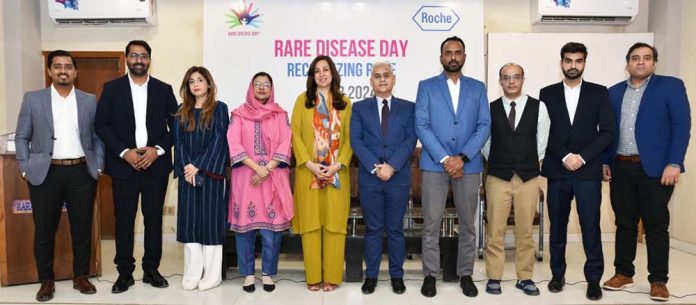In recognition of Rare Disease Day, Roche Pakistan Limited held a panel discussion and press briefing to raise awareness about rare diseases in Pakistan, and to emphasize the unmet needs of patients especially when it comes to awareness, funding and government support. The panel comprised MD Roche Pakistan, Ms. Hafsa Shamsie, Roche’s Head of Medical, Dr. Yasir Adnan as well as paeds neurologist Dr. Raman Kumar and hematologist Dr. Munira Borhany and Dr. Saqib Ali Shaikh, Director, Health Services, Govt of Sindh.
Ms. Hafsa Shamsie, MD Roche highlighted the fact that even for those who have been diagnosed, the lack of government healthcare spending and support makes the treatment burden for rare diseases even more difficult to bear. Rare diseases sufferers are the neglected outliers in Pakistan’s healthcare system. Roche is a company that is committed to serving rare disease patients by bringing innovative treatments that can help patients live a fully normal life or at least a much better quality of life. She shared that since 2017, Roche has run a Patient Support Program that has helped almost 25,000 patients with free of cost treatment for a number of diseases including Spinal Muscular Atrophy and Multiple Sclerosis. But as the burden of disease grows no one company or entity can go it alone. That is why it is critical to have the government on board through public private partnerships and it is time that “Recognizing Rare” becomes a healthcare priority too.
Dr. Saqib Ali Shaikh, Director Health Services, Karachi, Health Department, Government of Sindh, talked about the government’s robust commitment to strengthen the existing healthcare services and that at the same time the government recognizes the hidden burden of the rare diseases in the province. He updated the audience on government’s support being extended in response to increasing cases of Hemophilia in Sindh, and despite the budget constraints took the financial responsibility of few of the Hemophilia patients ongoing treatment through the Hemophilia Society in Sindh and was keen to support more patients in future.
He highlighted the significance of the Registry of Rare Diseases not only in Sindh but all over the Country. In this regard, he suggested that the data on few of the selected Rare Diseases on the basis of their prevalence can be part of the newly launched DHIS-2 (District Health information System) to further support the decision makers to formulate future policies on evidence-based data collected both from the Public & Private Sectors. He said that hope for addressing the Rare Diseases rested in Public-Private Partnerships like the ones that the government had initiated and was committed to pursuing for the health of the patients with rare diseases.
Dr. Yasir Adnan explained that worldwide about 300 million people live with a rare disease. Moreover, with Pakistan having over 240 million people, the rare disease incidence in this country becomes more acute with such a large population. Rare diseases like Multiple Sclerosis, Spinal Muscular Atrophy and Hemophilia pose not only debilitating physical and health challenges for the sufferer, but also grave challenges for the families of sufferers and for the society at large. He stated that worldwide, less than 10% of patients with rare diseases are treated. So the numbers of rare disease sufferers coming through the system is already an under representation – especially in a country with poverty and low literacy.
Dr. Raman Kumar said spinal muscular atrophy (SMA) is a severe neuromuscular disease and one of the leading genetic causes of infant death.. Dr. Kumar suggested that Govt/policymakers should work to support Rare Disease patients and capacity building of healthcare infrastructure to serve rare disease patients. Further, he encouraged all relevant stakeholders for empowering people living with SMA for equitable access to diagnosis, treatment care and social opportunities.
Dr. Munira Borhany explained that Hemophilia A is a debilitating and life-threatening bleeding disorder. Hemophilia A severely affects the quality of life of patients who may experience spontaneous bleeding and bleeding due to trauma within the muscles, joints, and other internal organs. These bleeding episodes may either end up to be fatal, or result in permanent joint disability. Hemophilia A, patients experience long-term psychosocial impacts as well. Children face barriers to socialization (missed school, unable to play with friends), leading to impact on education and career decisions. She said there is a dire need for our provincial governments to provide utmost support, especially in terms of standard-of-care treatment, so that patients could live normal lives and become active members of society.


